This was published 7 years ago
Vientiane, Laos travel guide and things to do: A capital of calm
By John Borthwick
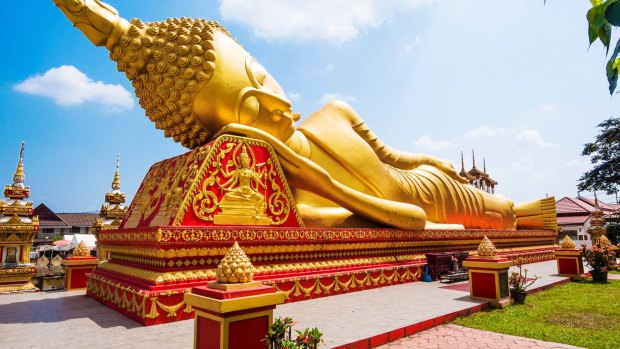
Reclining Buddha at Wat Pha That Luang.Credit: iStock
One of the great attractions of Vientiane, capital of Laos, is that there are no great attractions. It serenely lacks those must-see-must-do, fridge-magnet moments that aspiring tourist towns seem increasingly obliged to boast.
Landing in Vientiane prepares you for this refreshingly clean slate. Your aircraft glides over rice paddies and orderly suburbs of iron roofs rather than a horizon-wide megalopolis of concrete, glass and highways. It's a modest town both in dimensions and demeanour, an impression that is first established at the airport when you are neither scrum-tackled by touts nor mercilessly gouged on the taxi fare into town.
Fifty-three thousand Lao kip, the fixed price for the taxi ride, initially sounds preposterous, until you remember that the kip is three zeros over the limit of credibility. That is, once you deflate the price by knocking off its thousands — 53,000 becoming a sober 53 — the trip costs less than $9.
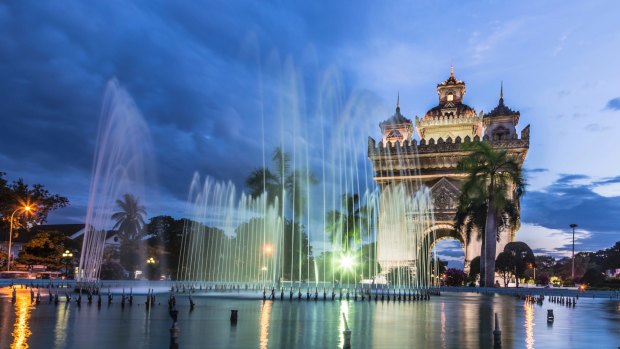
The Patuxai monument is dedicated to Laotians who died during World War II and during the independence war with France.Credit: iStock
To be fair, in the "attractions" department Vientiane does have a large and very important Buddhist temple, its national icon known as Pha That Luang — the Great Sacred Stupa — that dates back to 1566. It sprawls rather than soars and isn't burdened by being higher, holier or older than World Heritage wonders found elsewhere. In fact, years ago, on my first visit to Vientiane's graceful Ho Phakeo temple, a young guide told me that it had been home to Bangkok's famed Emerald Buddha until an invading Siamese army carried off the statue in 1779. "But we don't we ask for it back," he explained, "because the Thais have only the thing. The real Emerald Buddha is still here, inside us." Touche, Siam.
Vientiane (pronounced "Viang-chan" in Lao, rather than the Franglaise-style "Vee-enty-ahn") has been the Laotian capital for 453 years. It's a languid and friendly city where almost nothing is mandatory except to hang loose, eat well and wander at will. That said, most visitors take a good look at, if not climb, the Patuxai Gate, a huge, ornate archway that straddles the central Lane Xian Avenue. One of its two nicknames is the Asian Arc de Triomphe.
I climb to the top. The 160 steps are easy enough but in the Mekong-fuelled humidity, also a shirt drencher. The view is worth the sweat. You can scan the whole city horizon, counting its modest skyscrapers on one hand. Below you, the broad, Paris-inspired Lane Xian boulevard — playing Champs Elysee to Patuxai's Arc de Triomphe — stretches in one direction to the Presidential Palace and in the other towards Pha That Luang temple.
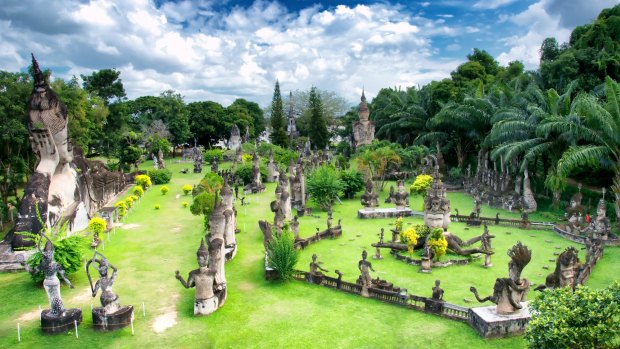
Buddha Park is 25kms southeast of Vientiane.Credit: iStock
Built between 1957 and 1968 (yet never quite completed), the victory arch is dedicated to the Laotians who died fighting for France in World War II or, soon after, against France in their struggle for independence. The oft-repeated local legend is that the cement used in constructing it was intended for concreting the US-funded Vientiane airport. Instead, much was diverted to erecting the Patuxai Gate — thus, its other nickname, "the vertical runway".
Exiting through the inevitable gift shop, I notice they're selling red hammer-and-sickle flags, a reminder that the Lao People's Democratic Republic (the country's official name) still tips its hat towards that enduring oxymoron, communism with galloping capitalist characteristics.
To get around town I skip the local tuk-tuk on steroids known as a Jumbo and, like many visitors, hire a bicycle. Vientiane is compact, its traffic ambles (even the peak hour jams are languid) and — the clincher for lazy cyclists like me — there are no hills. Pedaling in the constant steam-iron humidity, from hotel or cafe to museum or monument, I often find temptation looming: just skip the sights and have another cool drink — you know you want to. Resisting, I hit the National Museum where the Lao people get to tell their own tale.
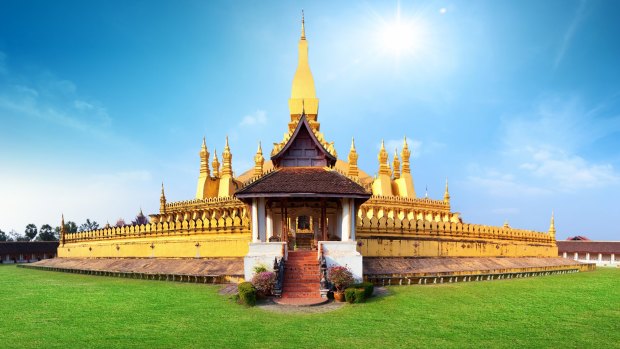
Golden pagoda wat Phra That Luang in Vientiane.Credit: iStock
That story stretches from a complex ethnography of 49 Austro-Asiatic and Tibeto-Burman tribal groups to displays of "how-we-kicked-the-French-derriere". (Laos' colonisers from 1893 to 1954, the French are depicted here as slavers with bullwhips.) The "American imperialists and their puppet soldiers", too, are shown the door. Probably all fair enough, as in matters of love and war. The propaganda is leavened by giant drums, tribal costumes, ceramics and ancient manuscripts, and occasionally lightened by the likes of the photo of that obscure, 1960s American leader, President John Sen. The last rooms, galleries of socialism's finest statistics — numbing, national "achievement" charts and the like — are a change from exiting through the gift shop.
The Lao People's Army Museum has impressive displays of what my friend Duncan calls "big, loud bits": Bofors anti-aircraft guns, artillery pieces and a Russian tank used in repelling a 1971 South Vietnamese invasion. The captions on its old photographs spell out historic Laotian character assessments of their enemies: the French, predictably, were "colonialists", the Japanese "fascists" and the Americans "imperialists", but the neighbouring Thais were inventively dubbed "extremely rightists".
I pedal across town to the shore of the Mekong River, except that the water is half a kilometre distant from the bank. This is dry season and broad, overgrown flats separate the river from the town. A wide promenade runs along the raised bank but gone are the old bars I remember, seemingly made of driftwood, that used to sit beside the stream in the 1990s, before big hydro dams were built upstream in China and reduced the flow. Here you could sink Beer Lao at sunset while trying to keep up with older locals who still liked to converse with foreigners in French.
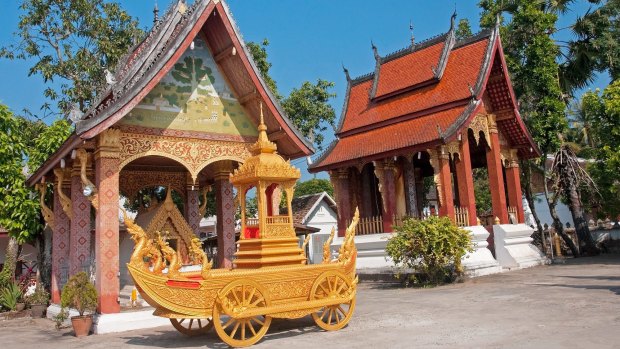
One of the many chapels of the temple in Luang Prabang.Credit: iStock
These days the built-up bank features, as well as its pedestrian quay and a busy roadway, a thronged night-market that is full of ethnic clobber, knick-knacks, bags and souvenir T-shirts. It's dinner time so I stroll further west along the bank's Quai Fa Ngoum, past a score of open-air eateries, all offering varieties of seafood, Lao food, Thai food and Western dishes. I settle for the Spirit House restaurant and feast there on steamed tilapia fish in chili, garlic and lime sauce with salad. Throw in a fair cocktail, good service and no plus-plus surcharges, and it comes to a princely $16.
Vientiane isn't an insomniac city with its nightlife on speed-dial. Going out here is more about enjoying good food and company and a drink. Khop Chai Deu (which is Lao for "thank you") attracts locals, expats and tourists alike, and is still the most popular bar-restaurant-beer garden in town. In an old villa on Setthathirath Road, a few paces from Nam Phou fountain (regarded as the unofficial centre of town), Khop Chai Deu is as good for an afternoon pit-stop (cold beer and fresh, spicy spring rolls) as it is for a dress-up, sit-down evening meal inside the villa.
Monty Python-style jokes about the colonial French might still get a run here, along the lines of "What did the French ever do for us?" The riposte includes boulevards, town planning, boulangeries, coffee, cafes, libraries, and so on. They also left a taste for dining well and when the austere decades of the Pathet Lao liberators and Cold War socialists were over, the chefs came out to rock again.
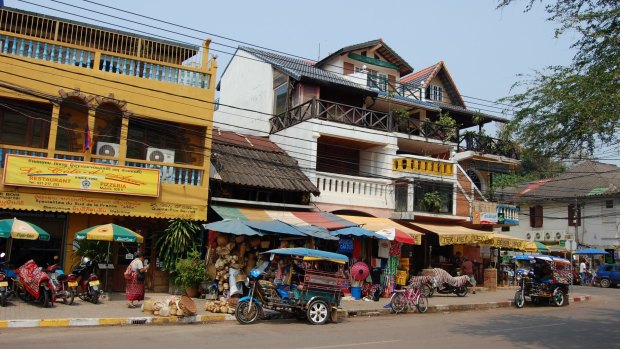
Tuk-tuks awaiting passengers. Credit: iStock
The best French restaurants in town include Le Comptoir, Le Silapa and L'Adresse. There are also plenty of Italian and Japanese and, not surprisingly, Thai options. For authentic Lao cuisine such as grilled bamboo salad with mint, or chicken soup with tamarind and roasted ground rice, try Doi Ka Noi restaurant on Sisangvone Road. In the mood for nothing special but a drink and a yarn, you can play pool in friendly bars like the Samlo Pub on Rue Setthathirath or watch Australian football at the Billabong Sports Bar on Rue Chao Anou.
The Mekong's liquid highway separates Laos from Thailand, visible on the opposite shore. There seem to be no Mekong sightseeing cruises or long-tail boat trips on offer. Instead, visitors wanting an out-of-town excursion make the 25-kilometre trip to a bizarre place called Buddha Park (Xieng Khuan), a scattered collection of huge sculptures depicting Buddhist and Hindu deities, plus sundry beasts. It was created beside the Mekong by a mystic-artist monk in the late 1950s and although he's long gone, his garden of syncretist concrete gods endures curiously.
Vientiane is its own agreeable enigma. A national capital of around 750,000 people, with all the urgency of a country town. Where you can rise before dawn to see the millennia-old dharma ritual that has outlived kings and cadres — monks on their daily rounds, receiving food from benefactors. It's done in front of temples that proudly proclaim being "smoke-free". Communism's old red rag, the hammer and sickle flag still droops redundantly from buildings like the Bibliotheque Nationale and the Ibis Hotel but many of the townfolk below have leap-frogged in one generation from flimsy motorbikes to bulky SUVs, seemingly without the intervening decades of ordinary sedans. A cosmopolitan town where you may equally spend Lao kip, American greenbacks or Thai baht on a street that might be called a rue, avenue, thanon, road or, indeed, a street.
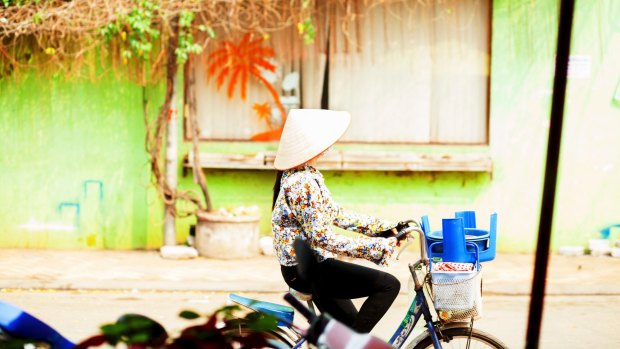
Vientiane's Rue Francois Ngin.Credit: iStock
It's all still amorphous, a chrysalis city. Enterprise is alive and kicking goals, and yet no louche touts accost you from darkened doorways, sketchy bars or tailor shops. Teens in trendy cafes like the quayside Amazon slurp iced cappuccinos that might cost as much as a Lao rural labourer makes in a day, but they're here for the Wi-Fi, and studying in teams, not slacking. Watch this city.
FIVE THINGS TO DO
1. HIRE A BICYCLE
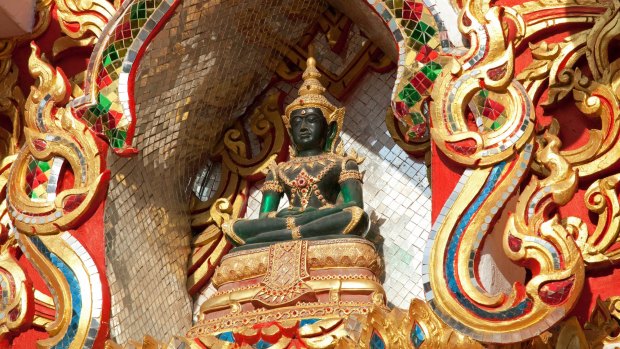
Buddah, Wat Chantaboury.Credit: John Borthwick
10,000 kip ($1.60) a day for a cheapie or 40,000 ($6.70) for a quality one from Bike Lao (corner Setthathirath Road and Rue Chao Anou). Pay in advance and leave some ID (not your passport).
2. VISIT PATUXAI, VICTORY ARCH
The fee is 5000 kip ($0.83). Climb to the top on the seventh floor. Also see Pha That Luang temple, four kilometres from the town centre.
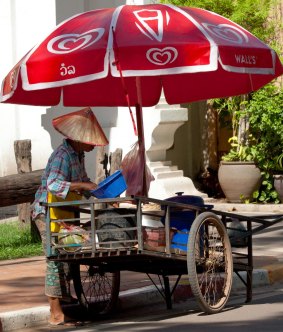
Vientiane food hawker.Credit: John Borthwick
3. WAT SISAKET MUSEUM
Corner of Lane Xang Avenue and Setthathirath Road and built in 1818, it is the oldest extant temple in Vientiane. Hundreds of Buddha images, plus murals. (Fee 5000 kip, $0.83)
4. GO SHOPPING
Look for quality Lao art, silks, textiles and handicrafts at T'Shop Lai Gallery, Vat Inpeng Street, or Carol Cassidy Textiles, Noekummane Road.
5. TAKE A TUK-TUK TOUR
Look at the major and lesser-known attractions in a tuk-tuk, including dining trips and home visits, with Tuktuk Safari, run by enterprising young Aussie-Lao couple Peta and Ere. See tuktuksafari.com
TRIP NOTES
MORE INFORMATION
GETTING THERE
It's a one-hour flight from Bangkok to Vientiane with Bangkok Airways (bangkokair.com/eng) or Thai International (thaiairways.com/en). A 30-day visa on arrival is available at the capital's Wattay International Airport. Current fee for Australian passport holders is $US30, payable in US currency or Thai baht. You'll need to bring a passport-sized photo. Vientiane is a year-round destination. May/June-October is monsoon.
STAYING THERE
Setana Boutique Hotel is a comfortable and friendly four-star retreat on Rue Chao Anou, one block from the Mekong and close to good eateries and cafes. See salanaboutique.com
MONEY MATTERS
One Australian dollar is worth about six thousand Lao kip. Three currencies are accepted: kip, US dollars (small denominations) and Thai baht. Notes only. Spend or exchange all kip before leaving the country; it is unusable elsewhere. There are ATMs. Credit cards are accepted in many places, though not universally.
WHERE TO FROM HERE
Vientiane is your jumping-off point for trips to, among others, World Heritage-listed Luang Prabang and the Mekong's Si Phan Don (Four Thousand Islands) archipelago. See laos-guide-999.com
John Borthwick was a guest of the Tourism Authority of Thailand.
Sign up for the Traveller Deals newsletter
Get exclusive travel deals delivered straight to your inbox. Sign up now.